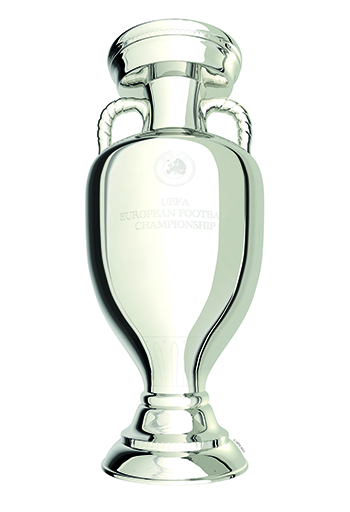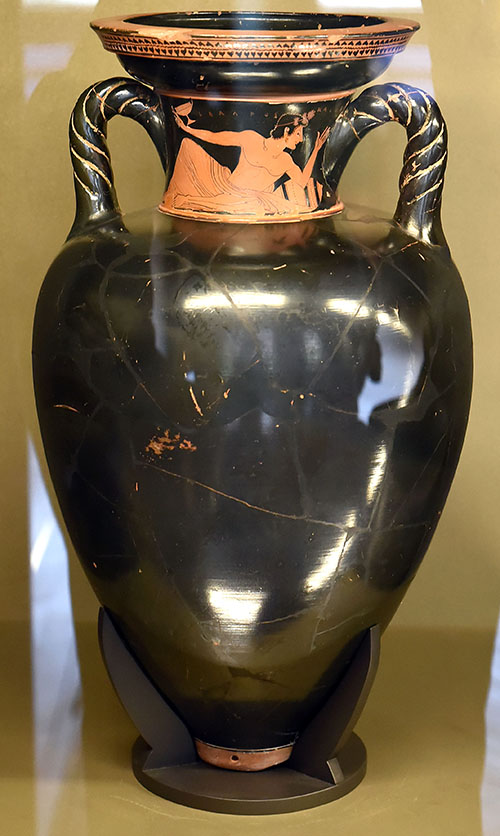Football fans watching the delayed UEFA European Championship 2020 should raise a glass to an ancient Greek artist who is the unsung hero behind the trophy will be held aloft by the glorious winners.
Avid fan and Italy supporter, Dr Andreas Kropp, a Classical archaeologist from the University of Nottingham, has spotted the trophy's more than passing resemblance to a specific ancient Greek amphora which he happens to show to students in his lectures on Greek vase painting. His research into its design and provenance, quickly revealed that there was very little meaningful public discussion about the trophy's obvious roots in Greek amphora prototypes.

The original UEFA cup was made in 1960 and named after Henri Delaunay, UEFA's first general secretary. For EURO 2008, an updated version was created, 18cm taller (60 cm) and 2kg heavier than the original. Unlike the original, which was the work of the goldsmith Chobillon and bought by Arthus-Bertrand in Paris, the making of the modern equivalent was entrusted to Asprey in London. But where did the inspiration for its design come from? What were the models and what ideas was this remake of an Attic amphora meant to convey?

Dr Kropp said: "No-one ever looks much at these trophies, right? I don't either, except something about this shiny silver pot caught my eye, and then I remembered that amphora from my first-year teaching. Both the overall design and details such as the twisted handles correspond closely to a red-figure neck amphora found in Vulci (Etruria), 47 cm high, dated c. 510 BC, now in the Louvre (a full description is in the Beazley Archive). It is ascribed to Euphronios, one of the pioneers of early 'red-figure' painting, best known for large-scale works such as a krater depicting a wrestling match between Herakles and Antaios.
"On the amphora, rather unusually,' says Andreas, "only the neck bears a figural scene. It shows a reclining banqueter with a wreath on his head holding his skyphos (drinking cup) with only the index finger of his right hand, playing a popular drinking game (kottabos). The inscription informs us that this man "Leagros is handsome" (Leagros kalos). His head is turned sharply to the right, presumably towards his companion on the other side of the vase's neck, a fellow reveller playing the lyre. It is a reminder of what luxury vessels like this were destined for, as showpieces at symposia."
To Andreas, the parallels with the EURO cup are glaring. The shape and proportions, the tapering lower body, the bulge at the shoulders, the almost cylindrical neck separated from the belly by a torus, and not least the twisted handles. "The silver trophy is not merely inspired by an Attic amphora," he says, "it is a neck amphora with twisted handles. It is not, however, an exact copy of Euphronios' piece as it differs at the base."

Neck amphoras with twisted handles, though not exactly common, were also made by Euphronios' contemporaries and successors down to the fourth century BC. Some later pieces share further similarities with the silver cup, such as the tongue-patterns on the shoulders and the bottom end of the body (some examples in the BM and in the Met in NY). While all these features were adapted from Classical prototypes by the creators of the trophy, they gave it a conical foot and a lip with an angular bottom edge, features that are not found in Greek amphoras and that give it a more monumental appearance.

The trophy has just toured the 11 host cities of the tournament and will feature everywhere in the EURO 2020 coverage on our screens and in the papers over the next few weeks. The official EURO 2020 logo itself is a clipart graphic of the trophy. So Dr Andreas Kropp is, for one, urging fans to take a moment to ponder this hitherto unacknowledged sporting tribute to the Athenian creative genius embodied by the silver cup.
"UEFA", he says, "won't tell the public about its trophy's debt of gratitude to Athens' finest potters and painters, and sadly Euphronios and consorts aren't here to sue for copyright violations."






